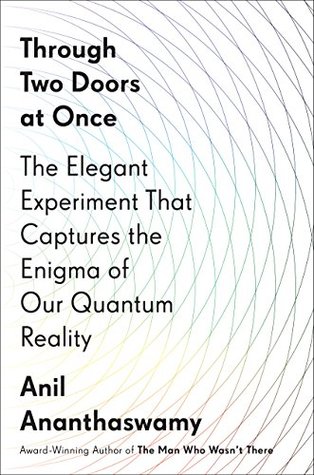More on this book
Community
Kindle Notes & Highlights
Read between
January 3 - January 6, 2020
The idea of an objective real world whose smallest parts exist objectively in the same sense as stones or trees exist, independently of whether or not we observe them . . . is impossible. —Werner Heisenberg
quantum mechanics.” The word mechanics refers to physics that can explain how something changes with time under the influence of forces.
The debate between Bohr and Schrödinger was a foretaste of future debates that Bohr would have with Einstein about how to think about the smallest constituents of reality (at the time, electrons and photons). It was a clash of two ways of thinking. As Walter Moore writes in his book Schrödinger: Life and Thought, “Schrödinger was a ‘visualizer’ and Bohr was a ‘nonvisualizer,’ one thought in terms of images and the other in terms of abstractions.”
“A cat is shut up in a steel chamber, together with the following diabolical apparatus (which one must keep out of the direct clutches of the cat): in a Geiger tube there is a tiny mass of radioactive substance, so little that in the course of an hour perhaps one atom of it disintegrates, but also with equal probability not even one; if it does happen, the [Geiger] counter responds and through a relay activates a hammer that shatters a little flask of prussic acid. If one has left this entire system to itself for an hour, then one will say to himself that the cat is still living, if in that
...more
Hermann straddled the worlds of philosophy and mathematics with ease. In 1935, she published a paper in a German journal in which she showed that von Neumann’s proof was incorrect. “A thorough examination of the proof of von Neumann reveals . . . that in his argumentation he makes an assumption which is equivalent to the statement he wants to prove,” she wrote. “Therefore, the proof is circular.”
Einstein, of course, was increasingly being thought of as a curmudgeonly old man who was holding on to his precious ideas of realism, locality, and at times even determinism. Though, to be fair to Einstein, the lack of determinism did not overly bother him. The overused quote of his in popular culture, that “God does not play dice with the world,” misrepresents his stand on the issue. He certainly did, during the early 1920s, express concerns about the indeterminate nature of the quantum world, saying that he found the idea “intolerable,” and if it were true, he “would rather be a cobbler, or
...more
Einstein did more than that. “He pointed the finger at these things not because as some people say he did not understand quantum mechanics,” said Zeilinger, but because he understood it very well.
“You are telling me that the particle doesn’t exist unless you observe it?” he’d ask. The instructor would go, “You can’t ask that question.” Bush felt he was back in Sunday school. It was galling to Bush that human observers could somehow be held responsible for creating quantum reality. It still galls him. “This is the latest in the long line of epic human intellectual follies that have resulted from man putting himself at the center of the universe,” he said when we met at his office at MIT. “It strikes me as nonsense.”
A university student attending lectures on general relativity in the morning and . . . on quantum mechanics in the afternoon, might be forgiven for concluding that his professors are fools, or they haven’t talked to each other for at least a century. —Carlo Rovelli
Say we send a photon through a beam splitter and let each path decohere, resulting in two separate worlds. Does the entire universe split into two everywhere at the same instant (and what does that mean, given that Einstein’s relativity abolished the notion of a universal “now”) or does it start splitting at the point where the decoherence happens near the beam splitter, and move outward at the speed of light? Opinions differ, and there’s no consensus, even among those who are not troubled by the idea of many worlds.
The debate over the status of the wavefunction has been at the heart of all the interpretations we have seen thus far. It can be broadly thought of in two ways: either that the wavefunction represents our knowledge of the quantum system, so it is epistemic, and theories that take this stance are called psi-epistemic; or that the wavefunction is part of reality itself, and theories of this persuasion are called psi-ontic (for ontology).
Some young minds—à la Heisenberg when he was twenty-four—might cut through this clutter. There’s insight in a comment that Anton Zeilinger made to Fuchs, after Fuchs had given a talk on QBism that wasn’t terribly well received in Fuchs’s own estimation. Fuchs thought that the veteran Alain Aspect, who was in the audience, had written him off “as a nutcase.” Even Mermin, a well-wisher, walked up to Fuchs and said, “We need to talk. That was the worst talk you’ve ever given.” Zeilinger said, “Great talk!” to which Mermin responded, “No, it wasn’t!” Fuchs recalled (in his writings) that Zeilinger
...more
In one talk, he asked his audience to consider two theories, A and B, which have different takes on the nature of reality but which are mathematically equivalent, make the same empirical predictions, and are impossible to tell apart experimentally (he could have been talking about the Copenhagen interpretation and Bohmian mechanics, but he wasn’t—he was making a general point). Feynman argued that it’s important to understand that the philosophies behind A and B can lead us in different directions even if they are indistinguishable at some stage of the scientific process. “In order to get new
...more


